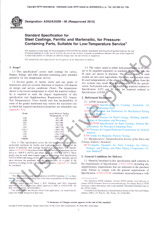We need your consent to use the individual data so that you can see information about your interests, among other things. Click "OK" to give your consent.
ASTM D8431-22
Standard Test Method for Detection of Water-soluble Petroleum Oils by A-TEEM Optical Spectroscopy and Multivariate Analysis
Translate name
STANDARD published on 1.5.2022
The information about the standard:
Designation standards: ASTM D8431-22
Publication date standards: 1.5.2022
SKU: NS-1067858
The number of pages: 15
Approximate weight : 45 g (0.10 lbs)
Country: American technical standard
Category: Technical standards ASTM
Annotation of standard text ASTM D8431-22 :
Keywords:
A-TEEM, CDOM, early warning, FDOM, oil spill detection and monitoring, surface water,
Additional information
| Significance and Use |
|
5.1?Source water protection calls for a rapid and reliable optical method to identify and quantify the oil spill contamination, such as water-soluble fraction of aromatic compounds from the BTEX family (benzene, toluene, ethylbenzene, and xylenes) and naphthalene from the polycyclic aromatic hydrocarbon (PAH) group. 5.2?This test method identifies the presence of contamination and quantifies the target contamination component(s) to provide a threshold-based alert signal. 5.3?This test method can be used by drinking water treatment plant operators and decision makers as a first line of defense for both initially detecting petroleum product spills, as well as tracking attenuation over time, in source water to prevent contaminant uptake into the processed water and treatment infrastructure. |
| 1. Scope |
|
1.1?This test method covers the (1) detection of trace level (?g/L range) of oil and petroleum (water-soluble fraction) pollutants in surface and ground drinking water sources, (2) identification of the compounds, and 1.2?The data sets are analyzed using multivariate methods to test contaminant identification and quantification. The multivariate methods include classification and regression algorithms to analyze fluorescence EEM data acquired in the laboratory. The common goal of these algorithms is to reduce multidimensionality and eliminate noise of fluorescence and background signals. Automated identification-quantification methods linked directly to the instrument acquisition-analysis software are commercially available. 1.3?The values stated in SI units are to be regarded as standard. No other units of measurement are included in this standard. 1.4?This standard does not purport to address all of the safety concerns, if any, associated with its use. It is the responsibility of the user of this standard to establish appropriate safety, health, and environmental practices and determine the applicability of regulatory limitations prior to use. 1.5?This international standard was developed in accordance with internationally recognized principles on standardization established in the Decision on Principles for the Development of International Standards, Guides and Recommendations issued by the World Trade Organization Technical Barriers to Trade (TBT) Committee. |



 Cookies
Cookies
